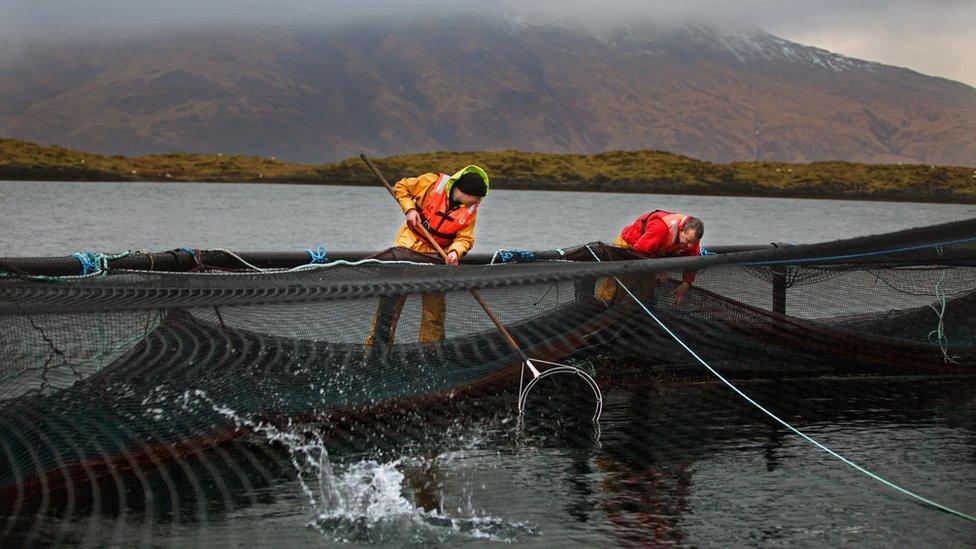Scaling up, moving out
- Published

Salmon farming is going through unprecedented change. Industry giant Mowi has offered to move away from "contentious" sea loch sites in north-west Scotland, in exchange for permission to replace the capacity in wilder waters.
Already the UK's leading food export, the industry has big plans for expansion, driving efficiency and production.
Norwegian companies are investing in trials of vast, deep-sea fish farms, which could see the industry move out of dependence on sea lochs and fjords.
It's 50 years or so since a ramshackle, welded cage was lowered into Lochailort, and salmon farming began.
In the first year of production, 1971, Unilever's subsidiary, Marine Harvest, produced a total of 14 tonnes from the site.
The industry has put on a lot of biomass since then. And other countries have overtaken Scotland, in output and in innovation - notably Norway, which also dominates corporate clout in the sector.
Scotland's salmon farming now accounts for Britain's biggest single food export, yet it also represents merely 6% of global production.
It commands a premium price, but its growth has been constrained by planning controls, which in turn have had to take into account the impact of salmon farms on sea loch conditions for wild fish.
High concentrations of salmon in cages creates a lot of waste in what they like to call the benthic zone, which most of us call the seabed.
Farmed salmon also have a growing appeal for sea lice. While the industry has been spending big to combat infestations - with chemicals, a warm water bath, and the "cleaner fish" which predate on lice - it has failed to get on top of the problem.
And sea lice aren't that fussy: they feed off wild species too. Indeed, that's how they got into the cages.
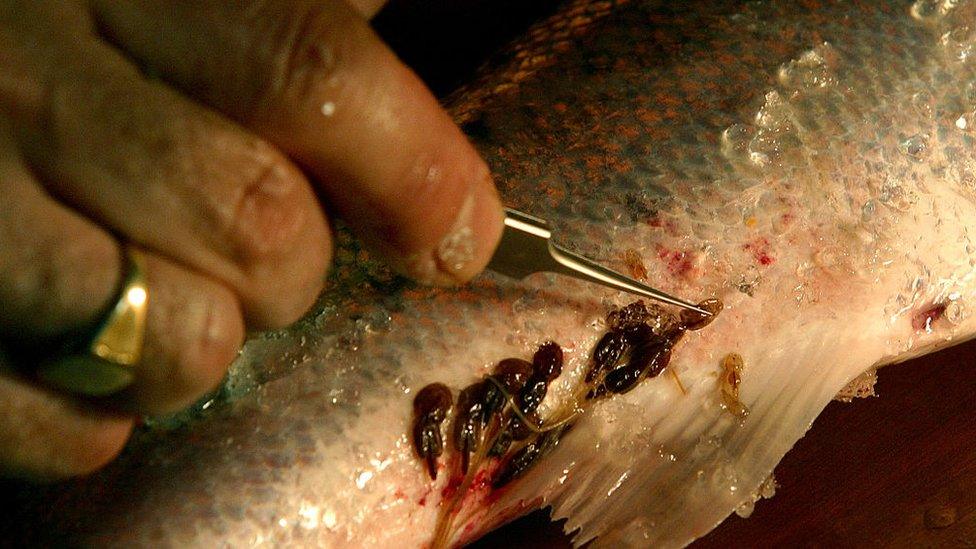
Sea lice were discovered on this wild salmon
Scotland's salmon farming industry is not alone in facing these challenges. Chile, also blessed with a long coastline of relatively sheltered fjords, has seen boom and bust due to disease.
On the west of Canada and the USA, environmental impact is hotly contested. After 30 years, and a very large escape, farming of the Atlantic salmon is being phased out in Washington state by 2022.
During spring this year, fish farms in northern Norway faced a very costly algal bloom, causing the death of eight million fish. Naturally occurring, hard to predict and possibly more likely due to climate change, a bloom's impact on cages seems anything but natural.
So salmon farming is risky, yet that doesn't stop the industry in Scotland wanting to grow. In October 2016, it set out a strategic plan which would see output double by 2030 to around 350,000 tonnes per year, and to £3.6bn in value.
That implies a 5% annual growth rate, which is far beyond what it has achieved, largely due to "biological" issues such as sea lice, requiring affected fish to be slaughtered long before their optimum weight.
To get to its targets, the industry wants to raise capacity, securing licences which would expand the maximum size of a fish farm site, bringing that closer to the more efficient Norwegian scale.

Millions of farmed salmon died in Norway due to an algal bloom
Norway has licences for sites of up to 10,000 tonnes of biomass. It supports the industry with the outlook that global leadership and investment in sustainable aquaculture is one of the country's best prospects after the oil runs out. It has set itself the target of being the world's leading producer of seafood.
Faced with losses due to mortality, those Norwegian farms affected by this year's algal bloom have been given 20% more allowance for the next five years, to help them make up for losses.
Meanwhile, until recently, the maximum Scottish tonnage per site was 2,500 tonnes. Regulation has been altered so that the maximum capacity is set by environmental impact (primarily, of salmon waste) rather than biomass tonnage.
The industry would like more sites in sea lochs, but it recognises that it's not going to be easy to secure them - not while campaigners and MSPs are on its case. A committee report last year called for tougher regulation. It did not support calls for a moratorium, but it warned of some sites having unacceptably high fish mortality, and had 65 recommendations for improvements.
Forcing compromise
There is a potential game-changer, and it relates to the flimsiness of that ramshackle welded cage back in 1971. The fish have been in sea lochs because their cages have not been able to withstand the battering of wilder waters.
If they build the cages stronger, they can expand the area where aquaculture can take place.
And that is what is happening. Led by Norwegian trials, bigger cages have been put further out at sea, anchored to the seabed. They are better designed to withstand seal attacks, with a net over the top to discourage birds. Crucially, they are designed to withstand big storms.
So Mowi - formarly Marine Harvest, the industry giant, based in Norway - announced on Tuesday that it wants to vacate two of the most "contentious" sites, in Loch Ewe and Loch Duich.
That is an explicit recognition that the battle with those who speak for wild fish stocks is forcing some compromise. The Mowi offer is conditional: to give up on the contentious sites only in order to relocate, taking with them at least the same capacity, and with a five-year expansion plan being pursued.
That is, there must be the same capacity further offshore, and the industry will be back for more after that.
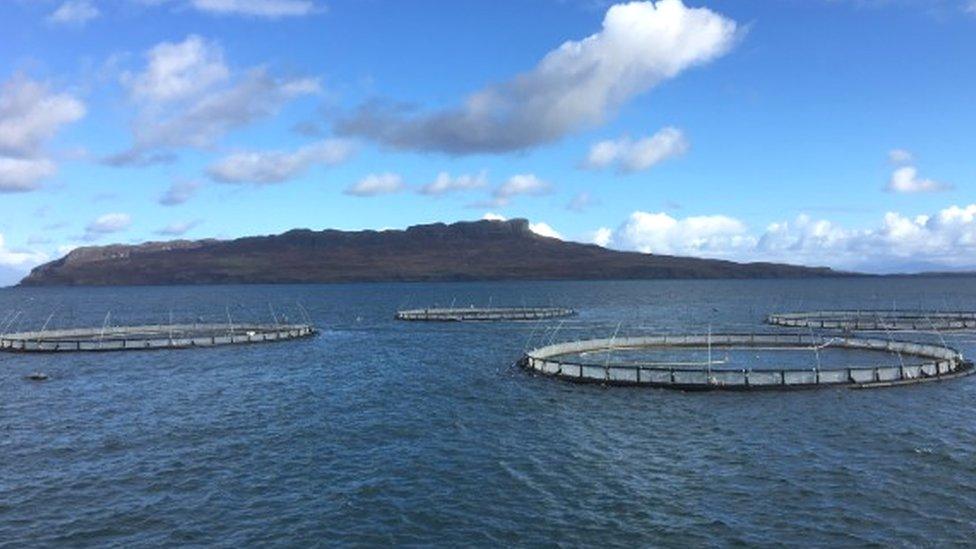
Mowi operates a high-energy site off the Isle of Muck
Mowi has stronger cages in "high energy" sites off the small Hebridean isles of Muck and Rum. It is willing to put more fish into such sites, if it is given permission.
That ought to be easier to secure than near-shore sites. Stronger currents and tides should disperse salmon waste and disperse its harmful effects. They might also force the salmon to swim harder, thus firming up the texture of the meat, which is less muscled and firm than wild-caught salmon.
Different designs of pen are being deployed. Some are trialling methods of keeping salmon below the level, around 3m down, where sea lice thrive. A "snorkel" in the design allows the fish to access oxygen briefly.
Others are trying out very large collecting sacks for salmon poop, with the prospect not only of removing it and the harm it can do, but for recycling into fertiliser.
Among the most ambitious is SalMar, which owns half of Scottish Sea Farms, the second biggest producer in the UK. It has invested US$70m in the Ocean Farm project.
Built in China, with a tubular design, the cage has been shipped to the North Sea. Fitted with sensors, it can pump feed into the water at a lower level in the cages, instead of the less-efficient method of depositing it at the surface.
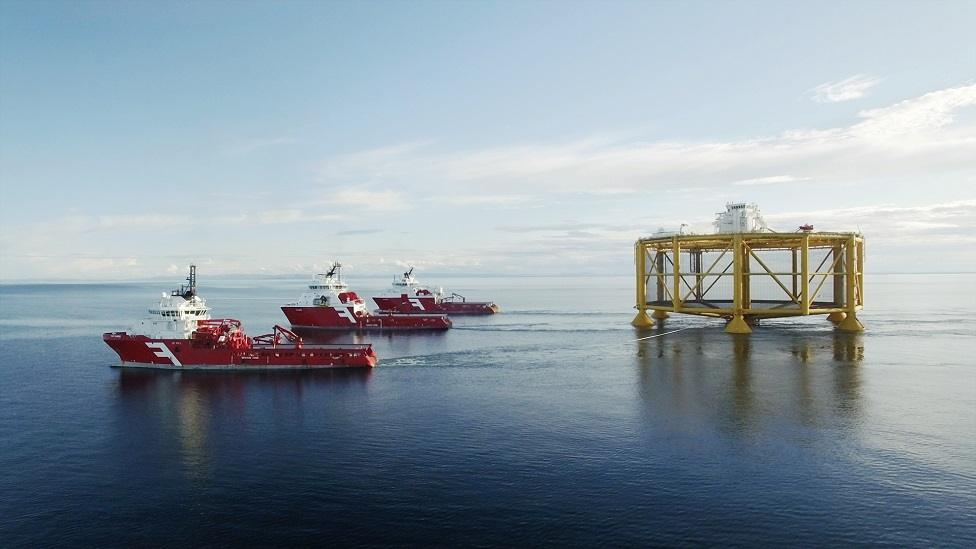
The Ocean Farm cage was towed into position
A much larger Smart Fish Farm is planned, for location 20 to 30 miles offshore, in the roughest of seas. It will be twice the size of the Ocean Farm - 170m in diameter, 60m in depth, with the capacity for three million fish.
The structure, resembling a spider's web, is to have a central, load-bearing column, to house the facility to harvest fish, as well as a control centre and research lab. To guard against the potential spread of disease, it will include treatment plants with which to isolate problems. In placing people offshore, safety is supposed to be equivalent to that found in the oil and gas industry.
Getting the necessary licences from the Norwegian government is not proving to be plain sailing. But if that scale of aquaculture can be made economic, it makes salmon farming a process that can be carried out anywhere in the ocean where there are the right water temperatures.
At the same time, with farmed fish and shellfish seen as a vital food source for the world's expanding population, there is growing talk of developing onshore aquaculture, in vast concrete drums. These would be for species that don't grow the way salmon, tuna and halibut do, notably shrimps and prawns.
For the Scottish industry, such developments offer both an opportunity and a challenge. With deep sea technology, if sea lochs become an unnecessary feature of production, Scotland could either be squeezed out, or it could be a base - if Norwegian investors give their support - from which the industry could continue to thrive.
And what about the building of large, fabricated steel structures, fit for use in hostile seas? There's quite a lot of capacity for that currently going unused at mothballed BiFab, as well as other former yards for offshore oil and gas.
Lest there be any doubt, Mowi's offer of moving out of those contentious sites in sea lochs is being welcomed by the Scottish Environment Protection Agency. Having the say on how much harm is being done, and whether it meets or fails the conditions of licences, a SEPA statement says it is "really encouraged to see the industry is proactiely choosing to consider more sustainable locations".
"SEPA's new regulatory framework for marine cage fish farming, launched on 1 June, combines more accurate modelling and enhanced monitoring to encourage a more sustainable approach to the siting of fish farms," it said.
"In practice, we anticipate this will lead to fewer fish farms in shallower, slow-flowing waters and more fish farms in offshore locations where the environment capacity can better assimilate wastes. The new framework is designed to actively support operators who are seeking to relocate to more sustainable locations, and through improved practices and the innovative use of new technologies, reduce their impact on the marine environment.
"Indeed, our new framework provides exactly the type of flexibility and outcome-focus Mowi outlines it is looking for. Within this new framework, we will consider each individual proposal on its merits against the legal standards."
- Published9 July 2019
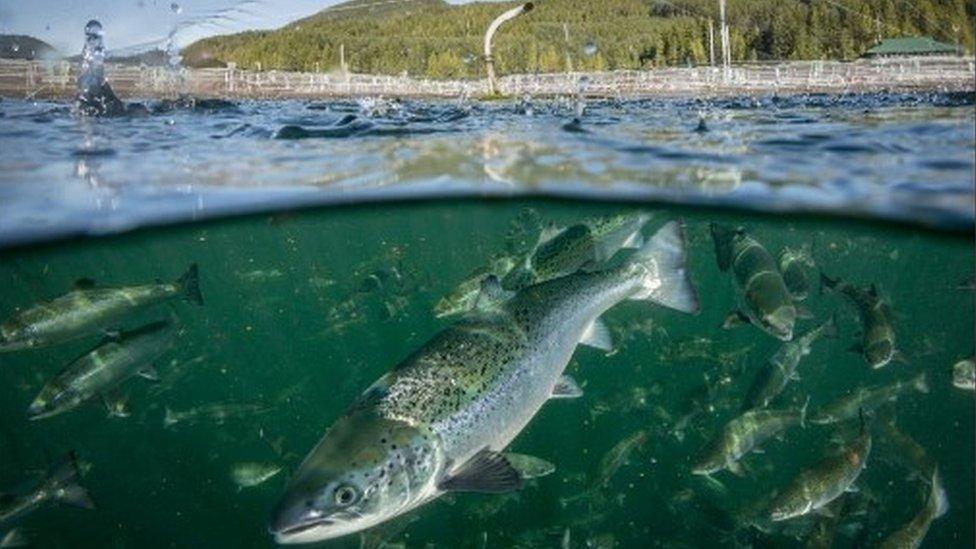
- Published20 May 2019

- Published27 November 2018
